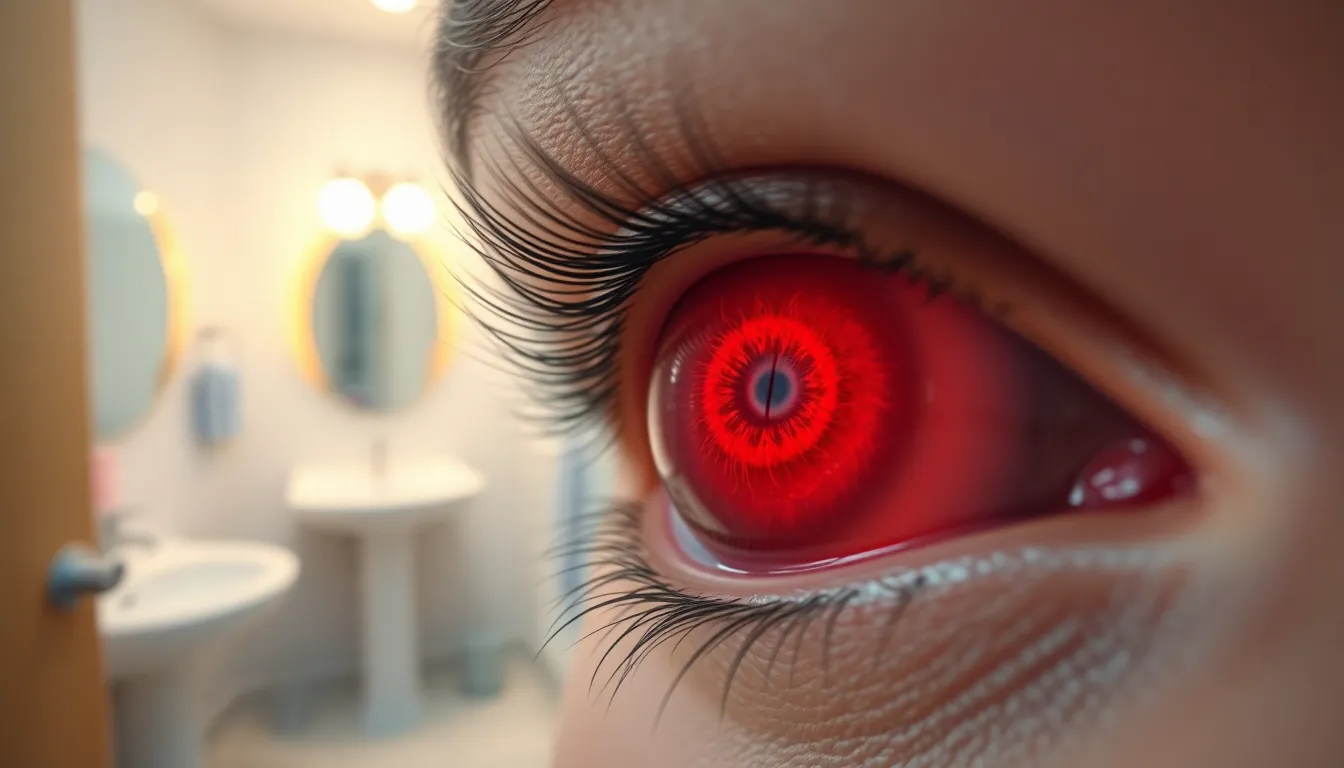An eye stye inside the lower eyelid can be both uncomfortable and concerning. This common condition often presents as a painful lump, causing irritation and redness. While styes can happen to anyone, understanding their causes and symptoms can help in managing them effectively.
Identifying a stye early on is crucial for treatment. Often mistaken for a pimple, it’s essential to recognize the difference to avoid complications. Knowing when to seek medical advice can make all the difference in alleviating discomfort and promoting healing. In this article, we’ll explore the causes, symptoms, and effective home remedies to help ease the pain and prevent future occurrences.
Table of Contents
ToggleOverview of Eye Stye
An eye stye, also known as a hordeolum, typically manifests as a red, painful bump on the eyelid, often near the base of eyelashes. Styes develop when oil glands within the eyelid become blocked or infected. This condition can present in two forms: external styes, which occur on the outer eyelid, and internal styes, which develop inside the eyelid. Internal styes often produce discomfort due to their location.
Common causes include bacterial infections, typically from Staphylococcus species, poor eyelid hygiene, and chronic conditions such as blepharitis. Additionally, environmental factors like dust and allergens may contribute to infection risk. Symptoms usually include swelling, redness, tenderness, and in some cases, discharge from the affected area.
Diagnosis of an eye stye is generally straightforward and involves a visual examination. Healthcare professionals assess the characteristics of the bump, considering its location and symptoms. Treatment options often focus on alleviating discomfort and promoting healing. Warm compresses applied several times a day can help reduce swelling and promote drainage. Topical antibiotics may be prescribed if a bacterial infection persists.
Preventative measures include maintaining proper eyelid hygiene, avoiding touching the eyes with unclean hands, and refraining from using expired makeup. Following these practices can minimize the likelihood of developing styes in the future.
Causes of Eye Stye Inside Lower Eyelid

Eye styes inside the lower eyelid commonly arise from bacterial infections and blocked oil glands. Understanding these causes can aid in prevention and management.
Bacterial Infections
Bacterial infections frequently trigger the formation of eye styes. Staphylococcus bacteria, often found on the skin, can infect oil glands or hair follicles in the eyelid, leading to inflammation and pus accumulation. Poor hygiene practices, such as touching the eyes with unwashed hands or sharing eye makeup, increase the likelihood of bacterial exposure. In some instances, existing skin conditions or systemic issues may elevate the risk of infection.
Blocked Oil Glands
Blocked oil glands contribute significantly to eye styes. The meibomian glands, which produce oil to lubricate the eyelid, can become clogged with debris, dead skin cells, or excess oil. This blockage creates an ideal environment for bacterial growth and inflammation. Conditions like blepharitis, an inflammation of the eyelid margins, or using certain cosmetics can exacerbate gland obstruction. Regular eyelid hygiene helps mitigate the risk of gland blockage and subsequent stye formation.
Symptoms of Eye Stye
Eye styes inside the lower eyelid present with various symptoms that signal their presence. Identifying these symptoms early aids in appropriate management and relief.
Common Symptoms
- Redness typically occurs around the affected area, indicating inflammation.
- Swelling often manifests quickly, causing noticeable puffiness of the eyelid.
- Tenderness commonly develops, leading to discomfort during blinking or touching.
- Pain is usually localized, presenting as a sharp or throbbing sensation.
- Discharge may emerge, with pus forming at the site of the stye.
Severe Symptoms
- Intense pain can signify an advanced infection or increased pressure within the eyelid.
- Vision changes may occur if the stye presses against the eyeball or alters eyelid function.
- Fever sometimes develops, indicating a systemic response to infection.
- Persistent swelling that does not subside, potentially indicating complicating factors such as cellulitis.
- Increased sensitivity to light may arise, contributing to discomfort during exposure to bright conditions.
Treatment Options
Effective treatment for eye styes inside the lower eyelid typically involves both home remedies and medical interventions. These options help alleviate discomfort and promote healing.
Home Remedies
- Warm Compresses: Applying a warm compress to the affected area for 10-15 minutes several times a day reduces pain and encourages drainage of the stye.
- Eyelid Hygiene: Maintaining eyelid cleanliness with mild soap or eyelid scrub pads prevents irritants and bacteria from worsening the condition.
- Over-the-Counter Pain Relievers: Non-prescription medications like ibuprofen or acetaminophen can alleviate pain and reduce inflammation.
- Tea Bags: Using cooled, used tea bags can serve as a compress; tannins in tea may provide anti-inflammatory benefits.
- Avoiding Makeup: Refraining from using eye makeup during an active stye prevents further irritation and bacterial growth.
Medical Treatments
- Topical Antibiotics: If a bacterial infection is pronounced, healthcare providers may prescribe antibiotic ointments to eliminate the infection.
- Oral Antibiotics: In cases of severe infection or recurring styes, oral antibiotics may be necessary to combat bacteria effectively.
- Incision and Drainage: If the stye does not improve with home treatments, a doctor might perform a minor surgical procedure to drain the pus and relieve pressure.
- Corticosteroid Injections: For persistent cases, corticosteroids may be injected directly into the stye to reduce inflammation and swelling.
- Management of Underlying Conditions: Treating conditions like blepharitis or rosacea can help prevent future stye occurrences, improving overall eyelid health.
Prevention Tips
- Practice proper eyelid hygiene. Clean eyelids daily with mild soap and water or eyelid wipes. This reduces the risk of bacterial buildup and oil gland blockage.
- Avoid touching the eyes. Keep hands clean and refrain from touching the eye area to minimize the introduction of bacteria.
- Use clean cosmetics. Regularly replace makeup products, especially those used near the eyes. Avoid using expired cosmetics to prevent irritation and infection.
- Remove makeup before sleeping. Thoroughly cleanse makeup from the eyelids each night. This helps prevent clogged oil glands and potential infections.
- Manage skin conditions. Address issues like blepharitis, rosacea, or acne with appropriate treatments. Preventing these conditions can reduce the likelihood of stye development.
- Avoid sharing personal items. Do not share towels, pillows, or makeup tools to limit bacterial transmission.
- Stay hydrated and maintain a balanced diet. A well-rounded diet supports overall health, promoting better skin and gland function.
- Consult an eye care professional. Seek regular check-ups if prone to eye styes. An eye specialist can provide personalized advice and treatment options.
Eye styes inside the lower eyelid can be both uncomfortable and bothersome. Recognizing the symptoms early and understanding the causes are crucial steps in managing this condition effectively. With proper eyelid hygiene and timely treatment, individuals can alleviate discomfort and reduce the risk of complications.
Incorporating preventative measures into daily routines can significantly lower the chances of developing future styes. By maintaining clean habits and being mindful of eye care, individuals can enjoy healthier eyes and minimize the likelihood of encountering this common issue again.


